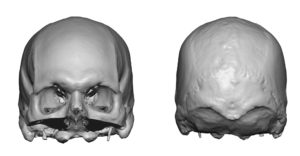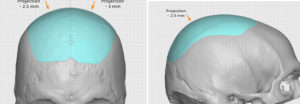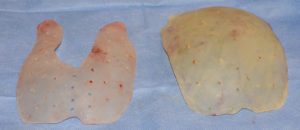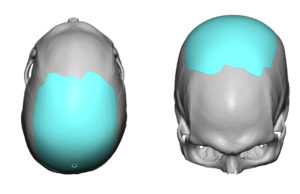Background: A sagittal ridge skull deformity is most commonly perceived as its fullest expression with sagittal craniosynotosis in an infant. But there are greater numbers of patients affected by lesser or more ‘aesthetic’ sagittal deformities where the height of the sagittal crest and the degree of parasagittal depression along the sides is much less severe. These may be known as microforms of sagittal craniosynostosis. But are probably better viewed as merely the range of shapes that can occur when a complex structure like a cranial suture must develop and eventually fuse.
The sagittal crest deformity is an adult manifestations of a raised bony ridge down the center of the head. It comes in degrees of manifestations with a linear relationship between the height of the ridge and the degree of parasagittal inclination along its sides. This is almost exclusively seen in the adult male patient who has thin hair or shaves his head where the shape or profile of the top of the head becomes a more prominent aesthetic feature.
The aesthetic treatment of a sagittal crest depends on its height. More moderate sagittal crests can be reduced by burring only. But whether become higher and the parasagittal shape becomes more inclined, midline burring alone is not going to create a more pleasing skull profile from the frontal view. The parasagittal area must be built up as well, usually done with a custom skull implant to complement the bony ridge reduction. Together, midline down and the sides up, can a more pleasing convex shape to the top of the head be achieved.



In more significant sagittal crest deformities the combination of a bony sagittal ridge reduction and parasagittal augmentation is usually the most effective approach to a more convex skull shape. But this involves a harmonious surface contour between three variables which in this case did not work to the patient’s aesthetic satisfaction. Changing to a complete skull implant design eventually created the best aesthetic result.
Highlights:
1) A smooth convex skull shape may not always result from the bony reduction of a prominent sagittal ridge.
2) The combined approach of a sagittal ridge reduction and a custom horse-shaped skull implant is effective the the sagittal ridge is more prominent.
3) When the perfect convex shape is not achieved by the combination of sagittal bone reduction and building up along the sides (parasagittal augmentation) then a custom skull implant that covers the complete top of the head may be needed.
Dr. Barry Eppley
Indianapolis, Indiana



